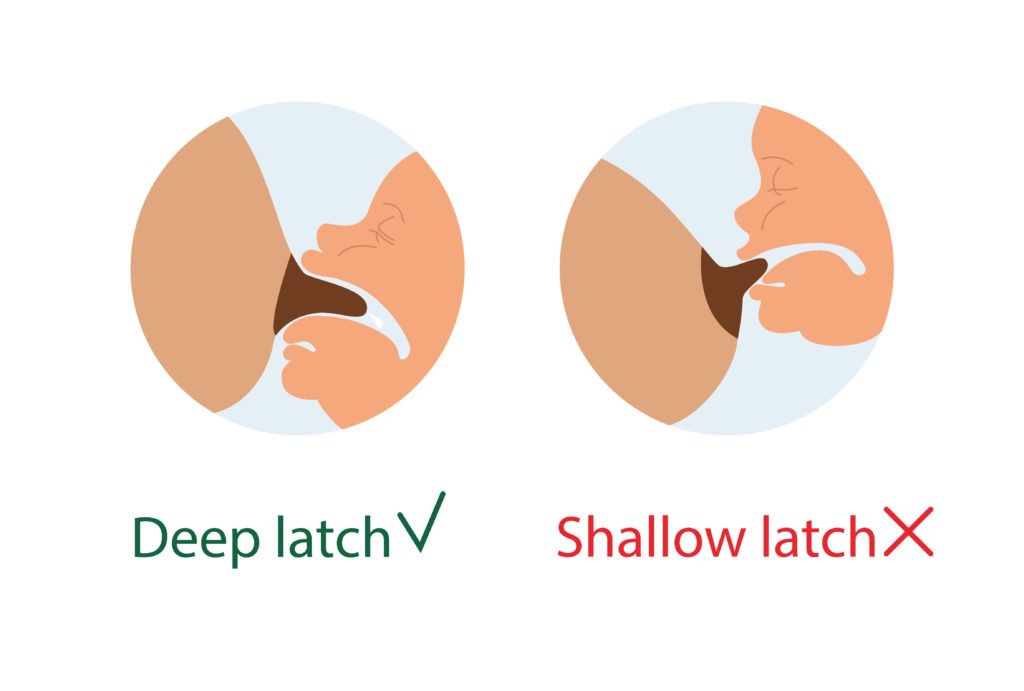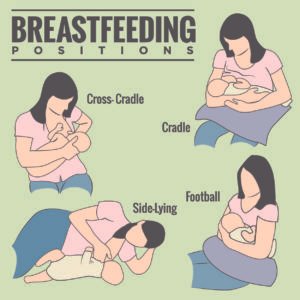If breastfeeding is causing you pain, it may be due to your baby’s shallow latch on your breast. Additionally, if you are giving your baby a bottle, a good latch is equally important. A shallow latch is very common for new breastfeeding moms and even moms that have had practice with another baby.
There are anatomical reasons why this can occur, such as a tongue or lip tie, and sometimes it’s a simple positioning issue. This post will help you navigate assessing your baby’s latch and how to easily fix a shallow latch so you can breastfeed your baby pain-free and actually enjoy your breastfeeding experience.
Please note that this article contains affiliate links, and that means that I may earn a commission if you buy something (at no additional cost to you). Read my full disclosure here. I only recommend products I use and love and recommend to my clients.
What Is a Shallow Latch?
A shallow latch while breastfeeding can cause a lot of pain for a mom and can affect milk transfer from you to your baby. If your baby has a shallow latch that means they aren’t opening their mouth wide enough to latch on to the entire breast well.
Most often, babies are sucking on part of the breast or just the nipple. If you are experiencing low milk supply, your baby being fussy, painful breastfeeding, sore or cracked nipples, or are just physically uncomfortable while breastfeeding, there could be a shallow latch issue.
Why Is a Proper Latch Important?
- The first 21 days calibrate your milk for future production, so proper milk removal in those first 21 days is very important.
- Helping your baby learn to latch well will prevent or minimize problems with sore nipples and engorgement.
- When a baby is latched well to your breast, he or she will be able to get plenty of milk at your breast.
- It’s much easier for your baby to learn how to latch efficiently in their first few weeks of life than it is to correct inefficient sucking habits down the road. A shallow latch is easily fixable with proper support during your early breastfeeding days.
For the above reasons, it is very crucial that you understand how to properly latch your baby to easily prevent a shallow latch. Whether you have or have not had your baby yet, be sure to line up a lactation specialist.
It’s best to speak with or have access to a lactation specialist before your baby arrives, but there’s a very good chance you are reading this post because you are currently struggling with a shallow latch.
As a Lactation Consultant, I highly recommend this online breastfeeding class, where you will learn how to establish a good latch for nursing and other tips to become successful at breastfeeding.

What Causes a Shallow Breastfeeding Latch?
A shallow breastfeeding latch is usually caused by a positioning issue, which is easily fixed when you learn how to bring your baby up to your breast comfortably.
Will a Shallow Latch Correct Itself?
Sometimes a breastfeeding mom and baby are able to figure out how to properly latch without any outside support. However, this is often not the case, which is why taking a breastfeeding course is so important. It can truly save your breastfeeding experience when you become empowered and educated on how to latch your baby.
Breastfeeding takes practice, and once you are able to practice more, sometimes a shallow latch will correct itself just from practicing and learning over a few weeks. This is not how I suggest managing a shallow latch though, especially if you are in pain or your baby isn’t gaining weight appropriately.
Your pediatrician can tell you if your baby is on track in regards to proper weight gain. A lactation specialist can also try to do a weighted feed before and after you nurse, but this is not always a guaranteed measurement.
Observing you and your baby while you nurse is a better solution to provide tips to easily fix a shallow latch. If you need a lactation specialist near you, contact your local La Leche League for help.
Research shows that moms often stop breastfeeding in the first two weeks after their baby is born because they don’t have proper support. I don’t want that to be you! Be sure to use the tips included in the post or seek lactation support for you and your baby.
Proper breastfeeding support can also help you rule out potential anatomical issues with your baby’s mouth such as a lip or tongue tie. If your baby isn’t able to physically suckle correctly, that may cause a decrease in weight gain for your baby and a decrease in milk supply for you. It may also cause engorgement in your breasts because the milk isn’t being removed efficiently even though you’re producing it.
Shallow Latch Signs To Watch Out For
If your baby is experiencing any of the following, they may have a shallow latch that needs fixing:
- Milk is dripping out of his or her mouth during feeding
- Your nipples are cracked or sore
- Breastfeeding feels painful
- It feels like your baby is pinching your nipple when suckling
- Baby’s weight gain is slow or not on track
- Your milk supply is low or not increasing during the first several days to weeks, or you are engorged
- Your baby’s lips aren’t flanged out like a fish
- Your baby’s cheeks are sunken in while they nurse
- You can hear noises coming from your baby’s mouth as they breastfeed like smacking or clicking
- Baby is extra gassy or fussy when not at the breast, which may indicate excess air in the digestive tract from nursing
How To Fix a Shallow Latch for Breastfeeding
Positioning is the most important aspect when trying to fix a shallow latch when breastfeeding. It is probably the easiest way to fix a shallow latch- when you find a position that works for you and your baby. Oftentimes, moms don’t bring the baby up close enough to them, or the baby isn’t aligned with the breast. Here are some tips to help you fix a shallow latch when breastfeeding.
Tip #1 - Ensure Proper Positioning for You and Your Baby
Here are a few basic tips to keep in mind when positioning your baby, regardless of the exact position you choose (football hold, cross-cradle hold, etc.).
- Comfort- Find a position that is both comfortable for you and your baby.
- Alignment- Make sure your baby’s ears, shoulders, and hips are aligned to make it easier to swallow and eat.
- Hips- Make sure your baby’s hips are flexed and his or her feet are against something for leverage.
- Pillows- Use a special nursing pillow, or other house pillows to provide you and your baby ample support.
- Neck support- Pillows are important because they help bring your baby up to you. You should not be hunched over your baby. Your baby comes to you, rather than you trying to put your breast to your baby. Stretch out your neck when you’re not nursing, otherwise, you may start to develop pain in your neck area from looking down at your baby. You can do this by putting your arms in an L-shape (think football goal post) and leaning your upper body forward through a doorway.
- Skin to skin- Initiate each feeding session with skin-to-skin contact with your baby to promote optimal body temperature and calmness for both you and your baby.
Tip #2 - Try Baby-led Latching
Baby-led latching is actually the most organic and natural for breastfeeding moms. This is designed to allow the baby to find the breast, much like they do when they are skin to skin with you after they are born.
When given an opportunity, babies will eventually bob their heads to make their way to your breast. Here are the steps for easy baby-led latching.
- Get yourself comfortable.
- Lean back with pillows to support your back, neck, and arms if necessary.
- Position your baby skin-to-skin between your breasts.
- Allow your baby to wake up and find your breast.
- Baby will bob head to latch on.
- Support and assist if necessary, but avoid directing the baby where to go.
- Be patient! Baby will latch on.
- Close your eyes or look at the baby and enjoy the relaxation.
- Great position when first learning to breastfeed and in the hospital.
Tip #3 - Try Mother-led Latching
Mother-led latching is what we traditionally consider breastfeeding or nursing our baby. Here are steps to practice mother-led latching:
- Find a position that is comfortable for both you and your baby. Laying back or cross-cradle are a few of the best when first starting.
- Start with your baby turned toward your body, close to you with the nose to your nipple. Don’t put pressure on the back of your baby’s head.
- Move your baby back an inch or two. Allow baby’s head to tilt back. Watch for your baby’s mouth to open wide.
- When your baby’s mouth is open wide, bring your baby in closer to you. Your nipple will be in the top half of your baby’s mouth.
- Your baby should be able to look up at you. This is the ideal distance for your baby to see you best.
- Your baby’s chin is against your breast, her lips make a seal on your breast, and the baby’s nose is close to the breast. There is more of the areola showing near the nose than the baby’s chin.
Tip #4- Try Different Positions
One position does not work for all moms. Positioning is important but so is being comfortable as you nurse. You want to find a position that allows your baby to come up to your breast. If you aren’t comfortable, try a different position.
The most common positions for new moms are the cross-cradle, cradle position, or baby-led latching with the baby on top of your chest. The football hold is often recommended too, but I am not a fan of the football hold unless you had a C-section and need your baby at your side rather than on top.
This position can be hard to navigate and hold although it is one of the most recommended by many lactation consultants. Here are some common breastfeeding positions you can try.


Tip #5- Look for Signs of a Deep Latch
It’s just as important to understand what a proper latch looks like. Here are some signs to look for in your nursing baby:
- You and baby are comfortable.
- No excruciating nipple pain; tugging feeling only.
- “Longer” nipples/erect, but not misshapen.
- Your baby’s tummy is to your tummy, turned toward you.
- The baby has his hands around the breast, which helps release oxytocin.
- Your baby’s mouth is wide open (at least 140 degrees), taking in a lot of your breast.
- Baby’s lips are turned outward.
- Your baby’s nose and chin should be touching your breast.
- Your baby is able to maintain suction on your breast.
- You can hear your baby swallowing (“keh keh” sound).
- Your baby ends the feeding with relaxed hands and body.
- The baby is gaining weight appropriately and diaper output is optimal for their age
Tip #6 - Seek Out Professional Help
First, start by talking to a lactation specialist who can observe and assess your baby’s latch. You can also try teaching yourself how to properly latch your baby through a breastfeeding course.
In a breastfeeding class you will learn everything you need to know to properly latch and position your baby straight from a certified lactation educator. There is an entire module dedicated to latching. There are other lessons in the course as well, such as mastering your milk supply and how to express and store breast milk.
If you still aren’t getting any relief from the above-mentioned symptoms of your baby’s shallow latch, seek out additional professional help, such as a chiropractor, occupational therapist, pediatric dentist, and/or speech therapist trained in babies and oral restrictions. This can really be a lifesaver if you and your baby are still struggling even after proper positioning.
All of these providers should give some level of care if your baby is diagnosed with an oral restriction- each is a specialist that can help you and your baby navigate how to easily fix a shallow latch through a correction.
Can I Use a Nipple Shield To Help With a Shallow Latch?
A nipple shield is a thin, silicone teat that can be placed over your nipple and may help a baby who is having difficulty learning to breastfeed. Holes in the tip allow milk to flow into the baby’s mouth. It can be used temporarily to ensure breastfeeding continues, but proper lactation support should also be pursued.
A shield ensures the teat is at the roof of the baby’s mouth. This helps the baby suck more effectively if they are having trouble. If you have flat or inverted nipples, a shield may also be helpful to help shape your nipple for your baby.
A nipple shield may be used to help with a shallow latch, but it is not recommended as the first method of fixing a baby’s latch. An assessment and support by a lactation consultant are important to ensure you are addressing any underlying problems.
It also can be difficult for some moms to wean their babies off of a nipple shield. Even with a shield, it’s important that your baby learns how to breastfeed well, and is ultimately able to achieve a deep latch. Only use a nipple shield as a last resort, if you do go this route I recommend a contact nipple shield from Lansinoh or Medela.
Best Bottles For a Shallow Latch
If you are giving your baby a bottle as well as nursing at the breast, the bottle you choose is just as important. Ensuring your baby is latched deep onto the bottle will help you transition back and forth between the breast and the bottle.
You want the bottle to mimic the breast experience as much as possible so your baby doesn’t develop a bottle preference (over the breast). This is a common issue with the moms I’ve worked with, so we have to work to find a bottle that is better suited for the baby and will help the baby latch on the breast again also.
You want to train your baby’s mouth muscles to get a deep latch when they’re sucking on the bottle and the earlier you do this the better. This is why the bottle nipple type is really important.
You’ll typically find three types of nipples/bottles on the market today.
- Nipples with a wide base and gradual slope from the tip, which is what you want. This can help support breastfeeding by encouraging your baby to suck with a wide mouth, ensuring that deep latch.
- Nipples with a more narrow base may work, but they don’t encourage the baby to open their mouth as wide.
- Bottles with a narrow teat that widen at the base will only promote sucking on the tip of the bottle. This is not ideal. You want your baby to take the entire nipple of the bottle in their mouth (or as much as possible) rather than just the tip.
The bottles I’ve recommended below fit into the category of a wide base, with a gradual slope.
Bottle #1- Lansinoh Glass Baby Bottles
This has the proper nipple shape with the gradual slope and is also a glass bottle. If you like glass bottles, this is the perfect option.
It meets the nipple shape and has fewer chemicals than the plastic bottle varieties. This is also an 8-ounce bottle, although babies don’t take that much milk at one time, you can save it or split the milk into two feedings.
Bottle #2- Dr. Brown’s Original Bottle
Dr. Brown’s is a very popular brand and for good reason. This nipple shape is ideal for a breastfed baby and will promote a deep latch. This is a 4-ounce bottle so it would be good for one feeding at a time. This bottle has a 4.7-star rating with over 20,000 ratings so moms like it!
Bottle #3- Lansinoh Baby Bottles
This is the ideal nipple shape to promote a deep latch and to prevent a shallow latch when sucking. This is a 5-ounce bottle and is a great option for moms and babies. With nearly 5 stars, this is another popular option among moms.
Bottle #4- Lifefactory Glass Baby Bottle with Silicone Sleeve
If you prefer to give your baby milk from a glass bottle, this is yet another superb option. It is second-best in the tier of proper nipple shapes and will help your baby form a wider mouth.
There are other factors that go into feeding your breastfed baby with the bottle such as positioning. Many moms say their baby won’t take a particular bottle, but oftentimes it has more to do with the nipple shape, positioning, environment, or who is offering the bottle.
If you are dealing with a shallow latch in your breastfed or bottle-fed baby, try the tips above in order to address the problem.
Breastfeeding is a wonderful experience between you and your baby when you and your baby are comfortable. Fixing a shallow latch is an important part of feeling comfortable when your baby is at the breast.
Finding the right position can take practice and time, but it is essential for a long-term breastfeeding journey. Before you go, don’t forget to seek out lactation help if you need it and sign up for the cost effective online breastfeeding class from Milkology to learn about proper latching and positioning. Thousands of moms have taken this course, including myself, and it is highly recommended to learn about latching and breastfeeding your baby.


 Is Weight Watchers Safe While Breastfeeding?
Is Weight Watchers Safe While Breastfeeding? »
»
Leave a Reply